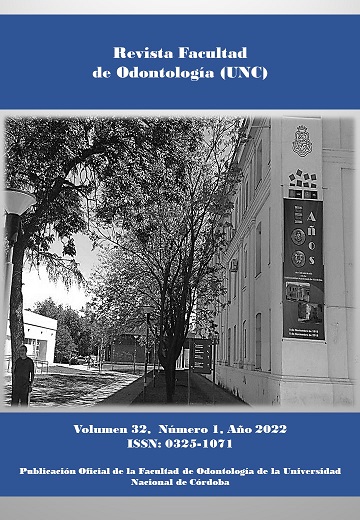Amalgam Tattoo: Clinical Case
Keywords:
Dental Amalgams, tattooing, argentum metallicum, pigmentation disorders, MaculaAbstract
The amalgam tattoo or focal argyrosis, is an iatrogenic lesion that follows the traumatic implantation of amalgam particles in soft tissue or the passive transfer by chronic friction of the mucosa against an amalgam restoration is characterized by the deposit of remains of restorative material composed of a mixture of silver, mercury, zinc, tin and copper in the connective tissue. Objective to present the clinical case of a patient with amalgam tattoo and the treatment that was carried out prior to his dental rehabilitation. Methods we did a diagnostic and excisional biopsy of the pigmentated lesion Result, as a result of the biopsy, we found that amalgam tattoo with a granulomatous reaction to a foreign body. Conclusion: By means of an excisional biopsy, the diagnosis of the lesion observed in the patient was verified, thus resulting in an amalgam tattoo with a granulomatous reaction to a foreign body.
References
1. Albuquerque DMdS, Cunha JLS, Roza ALOC, Arboleda LPA, Santos- Silva AR, Lopes MA, et al. Oral pigmented lesions: a retrospective analysis from Brazil. Med Oral Patol Oral Cir Bucal. 2021;26(3):e284-91.
2. Rosebush MS, Briody AN, Cordell KG. Black and Brown: Non-neoplastic Pigmentation of the Oral Mucosa. Head Neck Pathol. 2019;13(1):47-55.
3. Regezi JA, Sciubba JJ, Jordan RCK, Oral Pathology: Clinical Pathologic Correlations, 7th ed. China: Elsevier, 2017.
4. Neville BW, Damm DD, Allen CM, Chi AC, Oral and Maxillofacial Pathology, 4th ed. Canada: Elsevier, 2016.
5. Arjona-Aguilera C, Collantes-Rodríguez C, Gil-Jassogne C, Ossorio-García L, Jiménez-Gallo D. Pigmented oral lesion in a patient with metastatic melanoma. Indian J Dermatol Venereol Leprol. 2018 ;84(1):117-119.
6. Parizi J. Nai G. Amalgam tattoo: a cause of sinusitis?. Journal of Applied Oral Science. 2010;18(1):100-104.
7. GojkovVukelic M, Hadzic S, Pasic E. Laser Treatment of Oral Mucosa Tattoo. Acta Inform Med. 2011;19(4):244-246.
8. Gondak RO, da Silva-Jorge R, Jorge J, Lopes MA, Vargas PA. Oral pigmented lesions: Clinicopathologic features and review of the literature. Med Oral Patol Oral Cir Bucal. 2012;17(6):e919-24.
9. Lundin K, Schmidt G, Bonde C. Amalgam tattoo mimicking mucosal melanoma: a diagnostic dilemma revisited. Case Rep Dent. 2013;2013:787294.
10. Forsell M, Larsson B, Ljungqvist A, Carlmark B, Johansson O. Mercury content in amalgam tattoos of humanoral mucosa and its relation to local tissue reactions. Eur J Oral Sci. 1998;106(1):582-587.
11. Anusavice KJ. Philips ́ Science of Dental Materials: Elsevier 11th ed. Canada: Elsevier, 2003.
12. Vázquez ASJ, Sandoval SE, Chung R, García PMP, Cornejo VJA. Identification of Mercury Levels on the Operator’s FaceMask During the Removal Of Dental Amalgamas: Pilot Study. Adv Dent & Oral Health. 2017;3(3):55613.
13. Laimer J, Henn R, Helten T, Sprung S, Zelger B, Zelger B, Steiner R, Schnabl D, Offermanns V, Bruckmoser E, Huck CW. Amalgam tattoo versus melanocytic neoplasm - Differential diagnosis of dark pigmented oral mucosa lesions using infrared spectroscopy. PLoS One. 2018;13(11):e0207026.
14. Natarajan E. Black and Brown Oro-facial Mucocutaneous Neoplasms. Head Neck Pathol. 2019;13(1):56-70.
15. Yélamos O, Cordova M, Peterson G, Pulitzer MP, Singh B, Rajadhyaksha M, DeFazio JL. In vivo intraoral reflectance confocal microscopy of an amalgam tattoo. Dermatol Pract Concept. 2017;7(4):13-16.
Published
Issue
Section
License

This work is licensed under a Creative Commons Attribution-NonCommercial-ShareAlike 4.0 International License.
Aquellos autores/as que tengan publicaciones con esta revista, aceptan los términos siguientes:
- Los autores/as conservarán sus derechos de autor y garantizarán a la revista el derecho de primera publicación de su obra, el cuál estará simultáneamente sujeto a la Licencia de reconocimiento de Creative Commons que permite a terceros:
- Compartir — copiar y redistribuir el material en cualquier medio o formato
- La licenciante no puede revocar estas libertades en tanto usted siga los términos de la licencia
- Los autores/as podrán adoptar otros acuerdos de licencia no exclusiva de distribución de la versión de la obra publicada (p. ej.: depositarla en un archivo telemático institucional o publicarla en un volumen monográfico) siempre que se indique la publicación inicial en esta revista.
- Se permite y recomienda a los autores/as difundir su obra a través de Internet (p. ej.: en archivos telemáticos institucionales o en su página web) después del su publicación en la revista, lo cual puede producir intercambios interesantes y aumentar las citas de la obra publicada. (Véase El efecto del acceso abierto).

